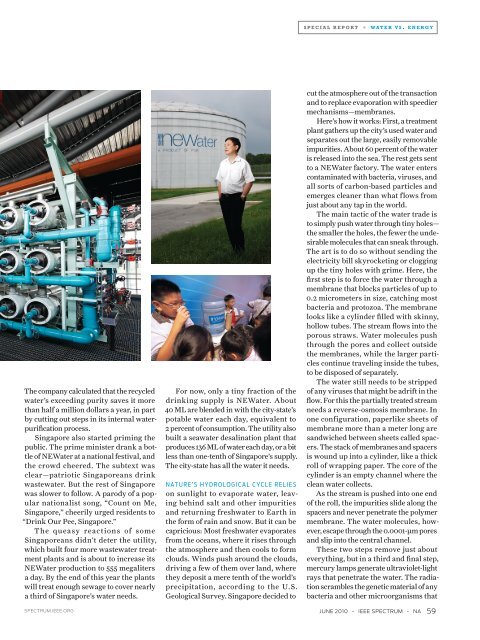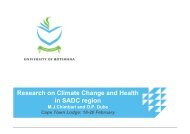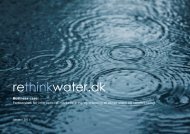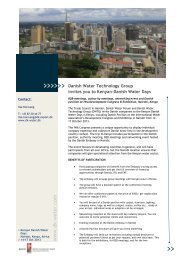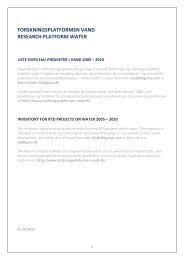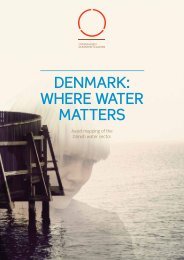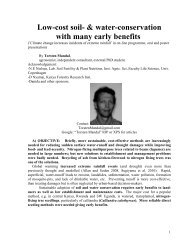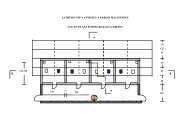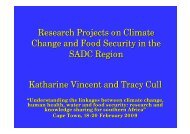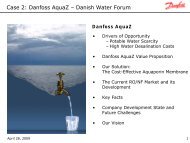s p e c i a l r e p o r t n w a t e r v s. e n e r g yThe company calculated that <strong>the</strong> re<strong>cycle</strong>d<strong>water</strong>’s exceeding purity saves it morethan half a million dollars a year, in partby cutting out steps in its internal <strong>water</strong>purificationprocess.Singapore also started priming <strong>the</strong>public. The prime minister drank a bottle<strong>of</strong> NEWater at a national festival, and<strong>the</strong> crowd cheered. The subtext wasclear—patriotic Singaporeans drinkwaste<strong>water</strong>. But <strong>the</strong> rest <strong>of</strong> Singaporewas slower to follow. A parody <strong>of</strong> a popularnationalist song, “Count on Me,Singapore,” cheerily urged residents to“Drink Our Pee, Singapore.”T he queasy reac t ions <strong>of</strong> someSingaporeans didn’t deter <strong>the</strong> utility,which built four more waste<strong>water</strong> treatmentplants and is about to increase itsNEWater production to 555 megalitersa day. By <strong>the</strong> end <strong>of</strong> this year <strong>the</strong> plantswill treat enough sewage to cover nearlya third <strong>of</strong> Singapore’s <strong>water</strong> needs.spectrum.ieee.orgFor now, only a tiny fraction <strong>of</strong> <strong>the</strong>drinking supply is NEWater. About40 ML are blended in with <strong>the</strong> city-state’spotable <strong>water</strong> each day, equivalent to2 percent <strong>of</strong> consumption. The utility alsobuilt a sea<strong>water</strong> desalination plant thatproduces 136 ML <strong>of</strong> <strong>water</strong> each day, or a bitless than one-tenth <strong>of</strong> Singapore’s supply.The city-state has all <strong>the</strong> <strong>water</strong> it needs.N at u r e ’ s h y d r o l o g i c a l c y c l e r e l i e son sunlight to evaporate <strong>water</strong>, leavingbehind salt and o<strong>the</strong>r impuritiesand returning fresh<strong>water</strong> to Earth in<strong>the</strong> form <strong>of</strong> rain and snow. But it can becapricious: Most fresh<strong>water</strong> evaporatesfrom <strong>the</strong> oceans, where it rises through<strong>the</strong> atmosphere and <strong>the</strong>n cools to formclouds. Winds push around <strong>the</strong> clouds,driving a few <strong>of</strong> <strong>the</strong>m over land, where<strong>the</strong>y deposit a mere tenth <strong>of</strong> <strong>the</strong> world’sprecipitation, according to <strong>the</strong> U.S.Geological Survey. Singapore decided tocut <strong>the</strong> atmosphere out <strong>of</strong> <strong>the</strong> transactionand to replace evaporation with speediermechanisms—membranes.Here’s how it works: First, a treatmentplant ga<strong>the</strong>rs up <strong>the</strong> city’s used <strong>water</strong> andseparates out <strong>the</strong> large, easily removableimpurities. About 60 percent <strong>of</strong> <strong>the</strong> <strong>water</strong>is released into <strong>the</strong> sea. The rest gets sentto a NEWater factory. The <strong>water</strong> enterscontaminated with bacteria, viruses, andall sorts <strong>of</strong> carbon-based particles andemerges cleaner than what flows fromjust about any tap in <strong>the</strong> world.The main tactic <strong>of</strong> <strong>the</strong> <strong>water</strong> trade isto simply push <strong>water</strong> through tiny holes—<strong>the</strong> smaller <strong>the</strong> holes, <strong>the</strong> fewer <strong>the</strong> undesirablemolecules that can sneak through.The art is to do so without sending <strong>the</strong>electricity bill skyrocketing or cloggingup <strong>the</strong> tiny holes with grime. Here, <strong>the</strong>first step is to force <strong>the</strong> <strong>water</strong> through amembrane that blocks particles <strong>of</strong> up to0.2 micrometers in size, catching mostbacteria and protozoa. The membranelooks like a cylinder filled with skinny,hollow tubes. The stream flows into <strong>the</strong>porous straws. Water molecules pushthrough <strong>the</strong> pores and collect outside<strong>the</strong> membranes, while <strong>the</strong> larger particlescontinue traveling inside <strong>the</strong> tubes,to be disposed <strong>of</strong> separately.The <strong>water</strong> still needs to be stripped<strong>of</strong> any viruses that might be adrift in <strong>the</strong>flow. For this <strong>the</strong> partially treated streamneeds a reverse-osmosis membrane. Inone configuration, paperlike sheets <strong>of</strong>membrane more than a meter long aresandwiched between sheets called spacers.The stack <strong>of</strong> membranes and spacersis wound up into a cylinder, like a thickroll <strong>of</strong> wrapping paper. The core <strong>of</strong> <strong>the</strong>cylinder is an empty channel where <strong>the</strong>clean <strong>water</strong> collects.As <strong>the</strong> stream is pushed into one end<strong>of</strong> <strong>the</strong> roll, <strong>the</strong> impurities slide along <strong>the</strong>spacers and never penetrate <strong>the</strong> polymermembrane. The <strong>water</strong> molecules, however,escape through <strong>the</strong> 0.0001-µm poresand slip into <strong>the</strong> central channel.These two steps remove just abouteverything, but in a third and final step,mercury lamps generate ultraviolet-lightrays that penetrate <strong>the</strong> <strong>water</strong>. The radiationscrambles <strong>the</strong> genetic material <strong>of</strong> anybacteria and o<strong>the</strong>r microorganisms thatjune 2010 • IEEE Spectrum • NA 59
3. t i n y t e s t b e d s n s i n g a p o r e n d e s a l i n a t i o n n m a l t aglacier or how much rain falls duringmonsoon season. Suddenly, Singapore is<strong>water</strong> rich. The <strong>water</strong> that falls from <strong>the</strong>sky may have once washed <strong>the</strong> streets <strong>of</strong>Paris or filled Cleopatra’s bathtub. Nowit’s augmented with some <strong>of</strong> <strong>the</strong> <strong>water</strong>used by Harry Seah, Asit Biswas, andeverybody else in Singapore. The utilityisn’t waiting for nature to turn its used<strong>water</strong> fresh again—it’s letting technologydo <strong>the</strong> job.might have slipped through, destroying<strong>the</strong>ir ability to reproduce. Now <strong>the</strong> <strong>water</strong>is ready for <strong>the</strong> tap.t h e S i g N i F i c a N c e o F N e Wat e r i S M u c hgreater than its literal contribution indrops or buckets or liters per person.“NEWater is key to our whole strategy,”Seah says.Seah is a s<strong>of</strong>t-spoken, dapper manwith a face that collapses frequentlyinto a brassy laugh. He’s been with <strong>the</strong>Public Utilities Board for almost twodecades, and he’s seen <strong>the</strong> NEWaterproject through to maturity. “The realbeauty <strong>of</strong> NEWater is its multiplyingeffect,” he explains. What he means isthat if <strong>the</strong> utility re<strong>cycle</strong>s 50 percent <strong>of</strong>its waste<strong>water</strong>, Singapore can squeezeone more drop out <strong>of</strong> every two it desalinatesor collects from <strong>the</strong> sky. “If I canachieve 100 percent recycling, I wouldn’teven need rain,” Seah says.That’s critical, given how few optionsSingapore has. Half <strong>of</strong> <strong>the</strong> island hasalready been converted into rain<strong>water</strong>catchment areas, and three new reservoirswill soon bring it to two-thirds. Theo<strong>the</strong>r source <strong>of</strong> fresh<strong>water</strong> is Singapore’sone desalination plant, which consumesso much energy it can cover only a fraction<strong>of</strong> <strong>the</strong> overall demand.Consider <strong>the</strong> details. To remove saltfrom sea<strong>water</strong>, Seah says <strong>the</strong> treatmentplant must apply a pressure <strong>of</strong> about7 megapascals. To remove impuritiest h e m a r i n ab a r r age t u r n Sa b ay i n t o ar e S e r voi r[at le f t ]p r o t e c t e d f r o mt h e S e a [ r ight ] .from waste<strong>water</strong>, he requires less than1 MPa. That translates directly into <strong>the</strong>energy cost for <strong>the</strong> whole plant—morethan 4 kilowatt-hours per thousand liters<strong>of</strong> <strong>water</strong> for sea<strong>water</strong> desalination, versus0.7 kWh for NEWater. “It’s a no-brainer,”says Seah, and his eyes crinkle into alaugh. “Win, win, win!” he says.Asit Biswas, an international <strong>water</strong>policyexper t who splits his timebetween <strong>the</strong> National University <strong>of</strong>Singapore and <strong>the</strong> Third World Centerfor Water Management, in Mexico, seesSingapore as one <strong>of</strong> <strong>the</strong> few places where<strong>the</strong> <strong>water</strong> authorities agree with his owncontroversial position—that <strong>water</strong> scarcitysimply does not exist. What doesexist, just about everywhere, is bad<strong>water</strong> management.The problem, he says, is that peopletend to assume that <strong>water</strong> is like oil orany o<strong>the</strong>r fossil fuel and that it behavesaccording to <strong>the</strong> same basic economicprinciples. “But <strong>water</strong> is not oil,” hesays. “Once we use oil, it breaks downinto various components. You can’tput it back toge<strong>the</strong>r.” Water, despiteits tendency to evaporate and trickleout <strong>of</strong> reach, doesn’t change its molecularstructure. “There is no limit tohow many times <strong>water</strong> can be reused,”Biswas points out.That simple fact radically changes <strong>the</strong>way that <strong>water</strong> is counted. What’s availableto a city or country is not just a matter<strong>of</strong> how much ice sits in a HimalayanN o t e V e r y o N e c a N B e c a J o l e d i N t odrinking re<strong>cycle</strong>d urine. In Queensland,Australia, and in San Diego, public opinionhas thwarted local utilities’ <strong>water</strong>-recyclingambitions. But at least three sitesin <strong>the</strong> United States—Scottsdale, Ariz.;Orange County, Calif.; and nor<strong>the</strong>rnVirginia—purify waste<strong>water</strong> and blend itinto <strong>the</strong>ir drinking <strong>water</strong>.In fact, most places reuse <strong>water</strong>—justwithout meaning to do so. According toPeter Gleick’s The World’s Water 2002–2003, each drop in <strong>the</strong> Colorado Riveris used 17 times. Similarly, residents <strong>of</strong>London drink <strong>water</strong> that was dischargedfrom numerous waste<strong>water</strong> treatmentplants upstream on <strong>the</strong> Thames.In Singapore’s case, <strong>the</strong> deliberatereuse <strong>of</strong> <strong>water</strong> has played a prominentrole in <strong>the</strong> country’s development.Seetharam Kallidaikurichi is <strong>the</strong> director<strong>of</strong> <strong>the</strong> Institute <strong>of</strong> Water Policy at <strong>the</strong>National University <strong>of</strong> Singapore, and heargues that Singapore’s <strong>water</strong> strategyhas been <strong>the</strong> foundation <strong>of</strong> <strong>the</strong> country’seconomic success in <strong>the</strong> last 45 years.“The evidence is beginning to emerge,”he says, “that it’s not <strong>water</strong> among manyo<strong>the</strong>r things but <strong>water</strong> as central, <strong>the</strong> keyto unlocking <strong>the</strong> vicious <strong>cycle</strong>s <strong>of</strong> deprivationand poverty into economic successand a good quality <strong>of</strong> life.”But prioritizing <strong>water</strong> means using aconsiderable amount <strong>of</strong> energy to makeit, clean it, and move it. The question ishow to optimize <strong>the</strong> juggle <strong>of</strong> resources.Because Singapore must import some290 billion cubic feet <strong>of</strong> natural gas to runits power plants, it can be said that <strong>the</strong>country has merely substituted one form<strong>of</strong> dependence for ano<strong>the</strong>r.The consequences <strong>of</strong> that dependenceare starting to hit home. Darren60 nA • ieee spectrum • june 2010 spectrum.ieee.org


